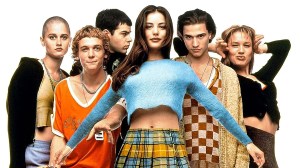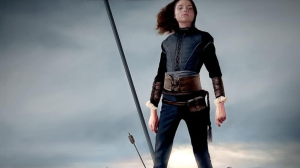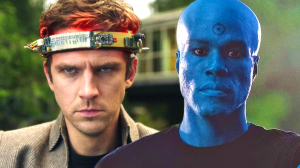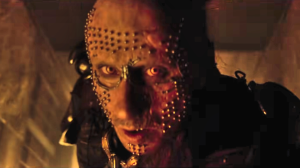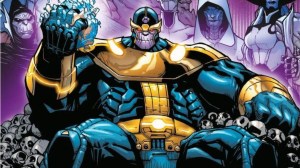
Fans of Rick Remender and Greg Tocchini’s Image Comics series Low should prepare to ascend from the depths. After a brief hiatus, the series is returning with a brand new story arc, “Shore of the Dying Light,” kicking off in February’s Low #11.
Videos by ComicBook.com
The new story arc promises to show a side of Low‘s world that the creative team has been eager to reveal, with post-apocalyptic family drama to fuel the narrative fire.
The prolific Remender took some time from schedule to talk to ComicBok.com about what fans should expect from Low‘s next act.
Can you remind our readers of where we’ve been so far with Low, and tell us where we’re heading in the new story arc?
Rick Remender: The story follows Stel and her two daughters who have been separated during an attack many, many years ago. They all live at the bottom of the ocean, as do all humans, trying to protect themselves from the ever-expanding sun. This is many, many, many millions of years in the future, and mankind has moved down there while they seek out probes to find new worlds to move to. So the first ten issues, we followed Stel as she has tried to make her way up to the surface, basically to be the first human to set foot on the surface in tens of thousands of years, to go acquire this probe that has returned to Earth.
In the new arc, we’re finally going to arrive there. We have two stories. We have Stel’s story. Stel will finally find out what’s on the surface and we get to see what’s been mutating up there all these years. And then we have the other story with her daughters, Tajo and Della, who have been reunited; both of them raised in different cities by different mad men after being torn away from Stel when they were children. This is sort of the fun part of the story. I wanted to make sure we earned the buildup to the surface and earned the character beats before getting there. Now we’re at a spot where we finally get to see what’s going on up there and how Greg has designed it all, which is pretty fantastic.

What can we expect to see from the relationship between Della and Tajo?
Rick Remender: They’re very different people, and as we’ve been building up Della, she has been raised in a city where hope is illegal. Hope is seen as cruel and unusual punishment because there is no hope and they’ve been down there for so many thousands of years now that holding onto hope only drives people crazy. So they, in the city of Volden, have found that if you can crush art and literature and hope that everybody can go about their day understanding the realities they live in without being burdened with the notion that things will get better. So she stands as a counterweight to Stel, who has sort of an eternal, unquenchable optimism.
Then there’s Tajo, who was raised in a city of pirates. She was sort of brainwashed and suffered a Stockholm-like syndrome dealing with her captor, who was the same man who killed her father. Now these two daughters are together with odd purpose. Tajo wants to go find Mom and help her in her mission, whereas Della has clearly drank the Kool-aid of Volden, and her desire is to only find Mother that she might crush the probe and do away with this false and cruel hope that her mother is spreading.
You mentioned that we’re going to see the surface for the first time, and one of the coolest things about the series for me has been these fantastic, underwater bottle cities. You’ve got the library turned into a hedonistic pirate city, and you had Volden, the city without hope. What other kind of interesting places in the world might we visit in this coming arc?
Rick Remender: In terms of the world-building, I wanted to keep what’s left of the bottom of the ocean limited, so all that was left at the beginning of the story was the three cities. There was Salis, which is sort of a democracy in collapse, there’s Volden, which is sort of a totalitarian regime that is crushing hope, and then there was the third city, Paloma, which, like you said, was this once-vast library and storehouse for scientific liches, and it was taken over by debaucherous pirate types. That city has been destroyed by Tajo as she fled it, which plays a lot into her state of mind and what she has to look forward to coming up after what she’s done.
The exciting stuff is now that we get to the surface, we get to see what’s up there. So the world-building and that kind of fun, getting to have Greg create new things, there is a whole new batch of civilizations and wonderful cities to be had on the surface. I don’t want to give away … there’s a number of surprises. Some of these things we’ve hinted at and seen in past issues, and we’ve shown glimpses of. Then there are a number of other things up there that we have not seen. So obviously, as Stel is seeking out the probe, she’s going to come into contact with these many civilizations, which allows me to go a little bit nuts and kind of dig into my love for Kamandi and cook up wild new things that have been mutating on the surface of Earth while mankind has been cowering in the lower depths of the ocean.
You mentioned it’s the giant, burning sun that’s caused man to retreat beneath the sea. As we go up, should we expect a landscape akin to the desert wastelands of Mad Max or Fallout, or is this one of the surprises that you have in store?
Rick Remender: Well, as it’s many, many, many years in the future, and the sun has prematurely begun its expansion process, there is extreme radiation and heat on the surface. So the first area that Stel arrives on is very acrid, and it’s been sun-bleached, and it’s quite radioactive, so they have to stay in their suits to stay protected from it. But there are surprises to come. That is the first step onto the surface, but as she progresses, there is a lot of stuff been going on up there which is kind of one of the things that I’ve been really eager to get to, the world-building that we’ve done up on the surface.

You work with a lot of talented artists on your creator-owned work. How is the relationship and the creative process with Greg Tocchini unique when compared to how you work with those other artists?
Rick Remender: Well Greg and I, we’ve established a strange working relationship. We started working together in 2008, 2009 on The Last Days of American Crime, and as we have progressed working together over the past seven years, we’ve kind of come in … he doesn’t speak English, he speaks Portuguese, and so we can’t get on the phone or Skype. I get on the phone and I Skype with all of my artists, so Sean [Gordon Murphy], and Matteo [Scalera], and Wes [Craig], and John [Wayshak], and all the guys I’m working with, we spend a lot of time on the phone talking out ideas and visuals and stories. And Greg and I don’t. We can’t do that.
What I do is I, every step of the way, I send Greg what I’m doing. So as we were developing this, I would send him a rough outline, and then Greg would do up some designs. And some of those designs were taken directly out of the outline, and some of them were just things that Greg saw in his head and drew. And then I would take those designs, and I would write character bits about them and send them back to Greg with ideas, and then he would sort of tweak and redesign, and then at the same time, I would incorporate them into the outline and keep some and discard others. It’s a very organic process that is a collaboration that happens without words. As we’re bouncing these things back and forth.
Oftentimes, what Greg designs is – the helmsuit, for example, became this amazing, huge part of the story and that was a lot because of the designs that he was turning in for what initially was just an aquatic suit. When I recognized that this one design he had done was so special, then that kind of struck me as, “Wow. The helmsuit is special. What if there’s only one of them?” And that gave the Caine family something that made them a little more unique in this world. So as the story kind of develops, we bounce these things back and forth, and it has a very fun and organic and collaborative methodology that ends up in something that is equal parts both of us.
One of the interesting elements of the series is how you’ve taken the philosophy of magical thinking and turned it into a kind of a religion within the world of Low. We’ve seen little glimpses of Stel with her mentor in that religion or philosophy, and I was wondering if that’s going to remain a background element, or if that’s something we might explore in the future?
Rick Remender: I definitely plan to do a little more. The religion itself is based on some interesting aspects of science and quantum theory about objects not actually taking their form until they’re viewed. Which is really heady stuff, but it got me thinking as I was reading about it that if what’s inside a present that’s given to me doesn’t actually solidify in form into that present – meaning that the reality I live in and the various possibilities of what are in there is a Roulette wheel until I open it and look at it – then the molecules form into this reality’s version of what was in that present. And this is stuff I’ve seen in documentaries, and read about quite a bit on futurism sites and new science. It’s very fascinating that life could have an effect on choosing the reality that it’s in, and I got to think that, what if your optimism, what if your perspective on something were actually to inform if it was a good thing or a bad thing inside that box?
And that’s really where Stel’s religion and the quantumology comes from. And we will see that dug into a little bit more and see some interesting things happen with that. Hopefully surprising and fun. I don’t want to give it away, but yeah, we’re definitely building to some stuff with that.

You’ve built this kind of spectrum of optimism between Della and Stel. Where would you put yourself on that spectrum? Are you more in tune with Stel’s irrational optimism, or more with Della’s extreme pessimism?
Rick Remender: I’d say I probably fall in the middle. The pendulum is always sort of swinging. There are days when writing Stel is easy for me, and there are days when, in order to sell the notion of that optimism, and to sell the notion of how she buys into this, is very difficult. Low #10 is one of the things, frankly, I’m most proud of in my career, but it was very, very, very difficult for me, because I had to sell, not only to the reader, but to myself how Stel holds onto this somewhat irrational optimism in the face of all of the horror that she’s up against. It all felt, not trite the first two, three, four drafts, it just felt easy, and it felt like there were holes in it that I was glossing over and expecting people to just take with a grain of salt and move on. I didn’t want to do that.
So I had to write pages and pages, and do a ton of research, and really get my head into her ability to maintain a positive attitude in the face of this stuff. That was quite difficult because I guess I lean a bit pessimistic as a person. In doing this exercise, and as somebody who leans pessimistic, it was quite cathartic. There was something really nice about it by the end, that I had found a way to sell myself on the notion of this, and hopefully maybe some readers, too. And based on the reaction we’ve had from the issue, I think we succeeded.
The series seems to spend a lot of time bringing its characters to their breaking point, only to have them snap back. Do you find that to be emotionally exhausting in any way, to have to dredge up that kind of dark place for them to go just so that you can pull them back out of it?
Rick Remender: I don’t know if it’s emotionally exhausting to write it. I know that I have to find ways to make them earn their ascension, and to earn their continued success, especially Stel. She had to earn that optimism, and obviously we’d seen her go through some terrible things in the first arc, so I wanted to take a moment to have her really start to question it, and to finally get to the darkest point in her story, where she had to really look very, very closely at it and analyze whether or not she could find a way to continue it, given the losses she had suffered and how hopeless things were.
It just feels to me, in a story like that, if you’re not going to have them up against the most insurmountable wall possible and at the lowest point, then what they earn coming out the other end of it isn’t as sweet. So for Stel, getting to finally make it to the surface and having risen up through all of this, it was a metaphor, obviously. Ultimately, what I think it does is it makes the character earn what they get out at the other end, and hopefully makes the reader going on that roller coaster journey, where you go down and then back up, hopefully the counterweight of the dark versus the light increases the joy when you see the character getting closer to what they want.
Low #11 goes on sale Feb. 10. Check out the gallery below to see more of Tocchini’s cover, concept, and interior art from Low #11.

